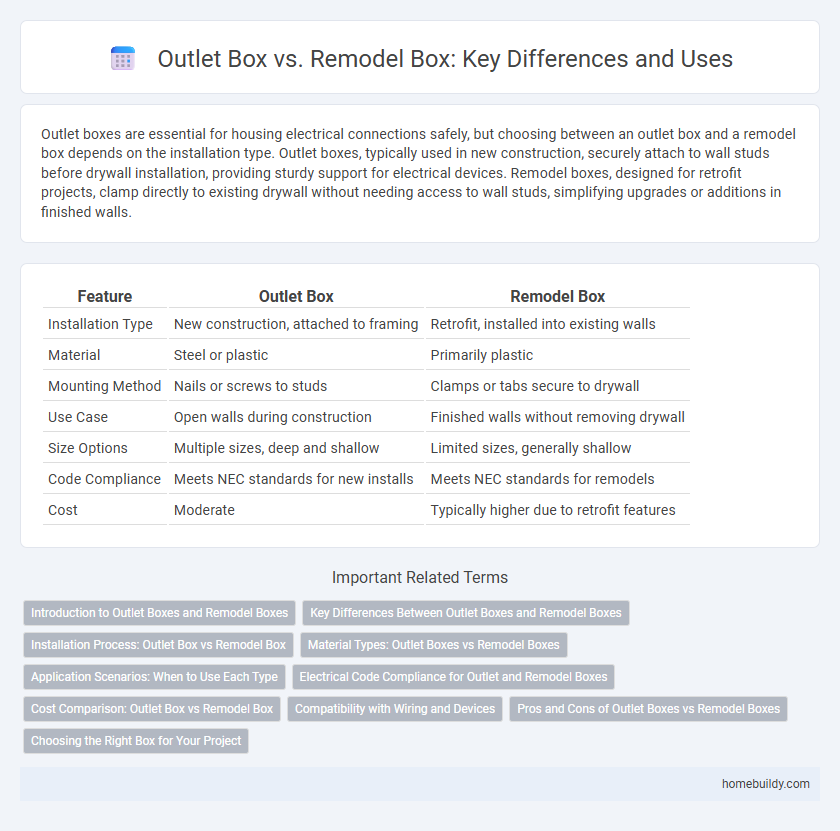Outlet boxes are essential for housing electrical connections safely, but choosing between an outlet box and a remodel box depends on the installation type. Outlet boxes, typically used in new construction, securely attach to wall studs before drywall installation, providing sturdy support for electrical devices. Remodel boxes, designed for retrofit projects, clamp directly to existing drywall without needing access to wall studs, simplifying upgrades or additions in finished walls.
Table of Comparison
| Feature | Outlet Box | Remodel Box |
|---|---|---|
| Installation Type | New construction, attached to framing | Retrofit, installed into existing walls |
| Material | Steel or plastic | Primarily plastic |
| Mounting Method | Nails or screws to studs | Clamps or tabs secure to drywall |
| Use Case | Open walls during construction | Finished walls without removing drywall |
| Size Options | Multiple sizes, deep and shallow | Limited sizes, generally shallow |
| Code Compliance | Meets NEC standards for new installs | Meets NEC standards for remodels |
| Cost | Moderate | Typically higher due to retrofit features |
Introduction to Outlet Boxes and Remodel Boxes
Outlet boxes serve as the essential housing units for electrical connections, securing wiring and devices like switches or outlets within walls. Remodel boxes are specifically designed for retrofitting installations, allowing secure attachment to existing drywall without requiring access to wall studs. Understanding the differences in installation methods and intended applications helps ensure proper selection for both new construction and remodeling projects.
Key Differences Between Outlet Boxes and Remodel Boxes
Outlet boxes are typically installed in new construction projects and securely attach to wall studs, providing a stable base for electrical devices. Remodel boxes are designed for retrofitting existing walls, allowing installation without accessing the wall studs by gripping the drywall from behind. The primary distinction lies in their installation methods and structural support, with outlet boxes offering more rigidity and remodel boxes emphasizing ease of insertion into finished walls.
Installation Process: Outlet Box vs Remodel Box
Outlet boxes require installation during the initial construction phase, being securely nailed or screwed to wall studs to provide sturdy support for electrical devices. Remodel boxes are designed for retrofitting, allowing installation directly into existing walls without needing access to studs, typically using mounting wings or clamps that secure the box by gripping the drywall. The Remodel box installation is faster and less invasive compared to the Outlet box, which demands structural integration for stability.
Material Types: Outlet Boxes vs Remodel Boxes
Outlet boxes are typically made from durable materials such as steel or heavy-duty plastic designed to provide sturdy support and withstand electrical wiring stresses. Remodel boxes often use lightweight plastic or flexible materials that facilitate easy installation behind existing drywall without the need for extensive wall modification. Steel outlet boxes offer superior grounding and fire resistance, whereas plastic remodel boxes prioritize ease of installation and corrosion resistance.
Application Scenarios: When to Use Each Type
Outlet boxes are ideal for new construction projects where wall framing is exposed, providing a secure anchor for electrical outlets and switches. Remodel boxes are designed for existing walls, allowing installation without removing drywall by clamping directly to the wall material. Use outlet boxes for rough-in wiring in open studs and remodel boxes when updating electrical fixtures in finished walls.
Electrical Code Compliance for Outlet and Remodel Boxes
Outlet boxes and remodel boxes must both comply with NEC (National Electrical Code) standards to ensure safety and functionality in electrical installations. Outlet boxes are designed for new construction, securely mounted to structural elements, while remodel boxes are specifically engineered for retrofit applications, attaching to drywall without structural support, yet both require proper box volume to accommodate wire fill and prevent overheating according to NEC Article 314. Proper grounding, secure installation, and adherence to box fill calculations are critical for both outlet and remodel boxes to meet electrical code compliance and maintain safe electrical connections.
Cost Comparison: Outlet Box vs Remodel Box
Outlet boxes generally cost between $1 and $5, making them a budget-friendly choice for new construction projects due to their straightforward installation within wall studs. Remodel boxes, designed for retrofit applications without wall access, typically range from $3 to $10, reflecting their specialized design and ease of installation in existing walls. The higher price of remodel boxes can be justified by labor savings and reduced wall damage during installation.
Compatibility with Wiring and Devices
Outlet boxes offer robust compatibility with a wide range of wiring types including non-metallic sheathed cable, conduit, and armored cable, ensuring secure connections for electrical devices. Remodel boxes are specifically designed for retrofitting applications, easily fitting into existing wall cavities without extensive wiring modifications, but may limit the size and type of devices that can be installed. Choosing between outlet and remodel boxes depends on the wiring configuration and device requirements to ensure proper installation and electrical safety compliance.
Pros and Cons of Outlet Boxes vs Remodel Boxes
Outlet boxes offer robust support for electrical fixtures, ensuring secure installation and compatibility with various wall types, but require wall framing access, which can be challenging in retrofit projects. Remodel boxes are designed for easy installation in existing walls without the need to open wall studs, providing convenience in renovation scenarios but may have limited weight capacity and less structural support. Choosing between outlet and remodel boxes depends on specific project requirements, balancing ease of installation against durability and load-bearing capacity.
Choosing the Right Box for Your Project
Outlet boxes are designed for new construction projects, featuring mounting brackets that attach directly to wall studs for secure installation. Remodel boxes, also known as old work boxes, are ideal for retrofitting or renovating existing walls, using clamps to secure within drywall without the need for stud access. Selecting the appropriate box depends on whether you're working with exposed framing or finished walls, ensuring safety, compliance with electrical codes, and ease of installation.
Outlet box vs Remodel box Infographic

 homebuildy.com
homebuildy.com